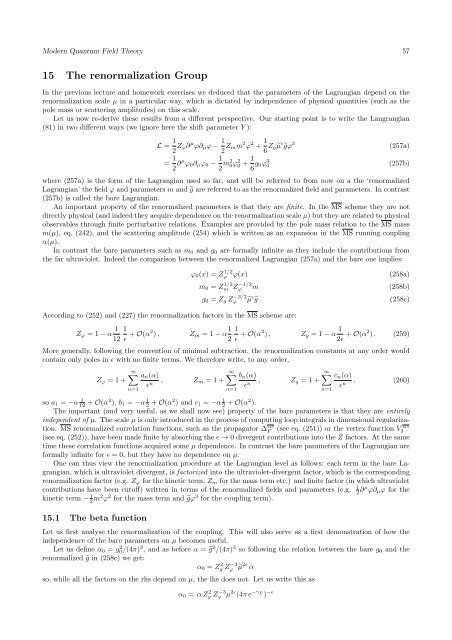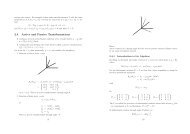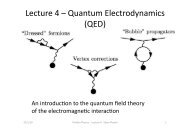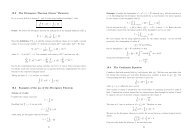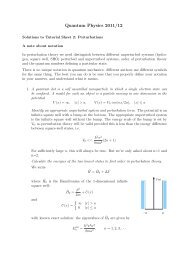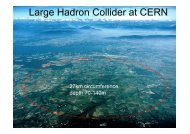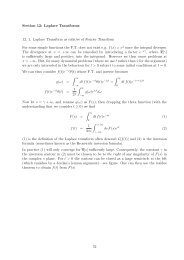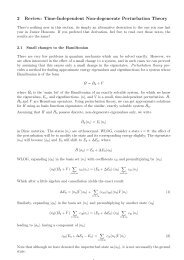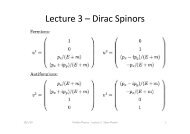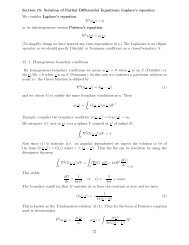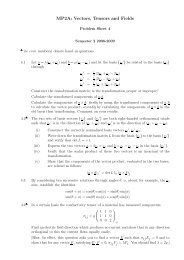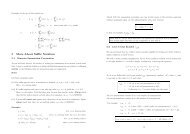15 The renormalization Group
15 The renormalization Group
15 The renormalization Group
Create successful ePaper yourself
Turn your PDF publications into a flip-book with our unique Google optimized e-Paper software.
Modern Quantum Field <strong>The</strong>ory 59where on the lhs we used the fact that the bare mass m 0 is µ independent. This determines the mass anomalousdimension asγ m ≡ d ln(m) −d ln µ = 1 d ln(Z m )+ 1 d ln(Z ϕ ) dα(264)2 dα 2 dα d ln µAt one-loop order we have according to (260):So at this accuracy 1γ m =4d ln(Z m )dα= − 1 21 + O(α) , d ln(Z ϕ )= − 1 1dα 12 + O(α)1 − 1 124 + O(α) −2α − 3 2 α2 + O(α 3 ) = − 5 12 α + O(α2 ) (265)where we used the evolution equation for the coupling (262).Note that this result is consistent with (245) which obtained in the previous lecture based on the fact that thepole mass is scale-independent.<strong>15</strong>.3 Callan-Symanzik equation for the propagator and the field anomalous dimensionExtending this idea we can now consider correlation functions built out of bare fields, ϕ 0 (x i ), which are also independentof µ. Since such bare correlation functions are related through (258a) to correlation functions of renormalizedfields,G (n) (x 1 ,x 2 ,...,x n ) ≡0| T(ϕ(x 1 )ϕ(x 2 ) ...ϕ(ϕ(x n )) |0 = Z −n/2ϕ 0| T(ϕ 0 (x 1 )ϕ 0 (x 2 ) ...ϕ(ϕ 0 (x n )) |0 (266)which in turn do depend on the scale (both directly and through the renormalized parameters) we obtain a powerfultool: we can deduce the scale dependence of a correlation function from its dependence on the renormalizedparameters, or conversely, deduce the beta function and anomalous dimension functions from computed correlationfunctions. This type of differential equation is called the Callan-Symanzik equation.Let us demonstrate this in case of the propagator. We define the bare propagator by∆ 0 (p 2 )= d d xe ip·x 0| T(ϕ 0 (x)ϕ 0 (0)) |0while the renormalized one is∆(p 2 )=d d xe ip·x 0| T(ϕ(x)ϕ(0)) |0with d = 6. Since these correlation functions have two powers of the field, they are related byTaking the logand a logarithmic derivative:0= d ln(Z ϕ)d ln µ + 1∆(p 2 )Defining the field anomalous dimension bywe get:∆ 0 (p 2 )=Z ϕ ∆(p 2 )ln( ∆ 0 (p 2 )) = ln(Z ϕ )+ln( ∆(p 2 ))∂ ∆(p 2 )∂ ln µ +dα d∆(p 2 )+ dmd ln µ dα d ln µd∆(p 2 )dmγ ϕ = 1 d ln(Z ϕ )2 d ln µ = 1 d ln(Z ϕ ) dα2 dα ln µ , (267)2γ ϕ +∂∂ ln µ + β(α) ddα + γ m m d dm∆(p 2 )=0. (268)which implies, in turn, that γ ϕ , similarly to the other anomalous dimensions, must be finite: all the other terms ineq. (268) are already known to be finite for → 0.
Modern Quantum Field <strong>The</strong>ory 60<strong>15</strong>.4 Exercises1. Verify that the one-loop propagator in a massless ϕ 3 theory (251) is consistent with the the Callan Symanzikequation.2. Consider the case of a massless ϕ 3 theory, and suppose that there is a non-trivial fixed point α ∗ where β(α ∗ ) = 0.Show that the Callan Symanzik equation for the propagator is solved by a power of the momentum which isdictated by the field anomalous dimension γ ϕ .3. In the ϕ 3 theory in six dimensions, define the <strong>renormalization</strong> factor in the on-shell scheme by ϕ 0 (x) = 1ZOS 2ϕ ϕ OS (x) whereϕ 0 is the bare field and ϕ OS the field renormalized on-shell. <strong>The</strong> one-loop result forthis <strong>renormalization</strong> factor has been computed in lecture 10, eq. (175). Similarly, define the analogous relationϕ 0 (x) = ZϕMS12ϕ MS (x) intheMS.(a) Compute the residue R MS of the propagator in the MS scheme, as defined in (246) in terms of the<strong>renormalization</strong> factors ZϕOS and Zϕ MS .(b) Use this to determine R MS at one-loop and compare with (255).(c) Obtain eq. (240) and explain how the Feynman rules change in the MS scheme compared to the on-shellscheme and why.


